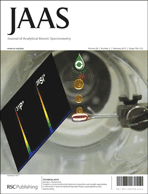
Determination of osmium in small biological samples
The high concentrations of osmium (Os) in sediments and the highly toxic nature of OsO4(a gaseous osmium oxide) have been the main interest of a number of studies. Isotope abundance ratio measurements of 187Os/188Os can provide valuable information about the source of Os, and concentration measurements can help define future toxicity effects. However, studies of biological samples are impeded by low accuracy and long measurement time of the available methods.
Nicola Pallavicini and colleagues at the Lulea University of Technology, Sweden, developed a methodology for the analysis of biological samples using double-focusing, sector field inductively coupled plasma mass spectrometry to measure the concentration of Os and also Os isotope ratio. The samples were prepared with microwave assisted acid digestion and spiked with Os of known isotope ratio. The method proved to be reproducible, relatively rapid and allowed high through-put of samples. The samples included different tissues from herbivore rodents and reference materials of biological and plant origin, allowing the method to provide information about Os metabolism and toxicity and also potential use of the Os isotope system in applications such as food authentication.
To read more about this article, please access the link below. This paper will be free to read October 18th.
A high-throughput method for the determination of Os concentrations and isotope ratio measurements in small-size biological samples
Nicola Pallavicini, Frauke Ecke, Emma Engström, Douglas C. Baxter and Ilia Rodushkin
J. Anal. At. Spectrom., 2013,28, 1591-1599
DOI: 10.1039/C3JA50201E





















